Living in the modern world and dealing with symptoms of stress is no easy task for the body. Ever increasing pressure emotionally to excel in our endeavors, along with an increasingly toxic environment and inadequate rest put tremendous strain on our body and create symptoms of stress. Scientists and researchers have been studying stress, the symptoms of stress, and our body’s response for decades. Many of us don't even realize just how many symptoms of stress our bodies experience on a regular basis in our daily lives or attribute the root of these symptoms of stress to something different entirely.
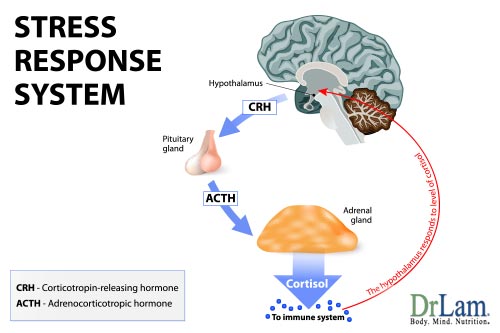 The fact that our neuroendocrine system is in charge of much of our stress response is well established. Much of this burden falls on the hypothalamic-pituitary-adrenal (HPA) hormone axis. This is the primary neuroendocrine highway where our brain receives stress signals through our senses, interprets and converts them into chemical messengers called neurotransmitter and hormones. These compounds are delivered to the proper target organ to effect further targeted action. They keep the brain on high alert and ready the heart to pump more blood in times of threat or while experienceing symptoms of stress. The main stress response control center and organ outside the central nervous system is the adrenal glands. Resting on top of our kidneys, these two walnut sized glands secrete over fifty hormones that help us deal with stress as well as the symptoms of stress. The most important anti-stress hormone of all is cortisol. Proper adrenal function is therefore essential for life and our wellbeing.
The fact that our neuroendocrine system is in charge of much of our stress response is well established. Much of this burden falls on the hypothalamic-pituitary-adrenal (HPA) hormone axis. This is the primary neuroendocrine highway where our brain receives stress signals through our senses, interprets and converts them into chemical messengers called neurotransmitter and hormones. These compounds are delivered to the proper target organ to effect further targeted action. They keep the brain on high alert and ready the heart to pump more blood in times of threat or while experienceing symptoms of stress. The main stress response control center and organ outside the central nervous system is the adrenal glands. Resting on top of our kidneys, these two walnut sized glands secrete over fifty hormones that help us deal with stress as well as the symptoms of stress. The most important anti-stress hormone of all is cortisol. Proper adrenal function is therefore essential for life and our wellbeing.
Without a properly functioning HPA axis and proper levels of cortisol output by the adrenals, the body will not be able to handle stress well. The slightest stress can be intolerable. Daily living becomes overburdened just with keeping up routine chores. Excessive or chronic stress, however, can overburden the adrenals so that its hormonal output becomes dysregulated over time. In early stages of stress response, cortisol levels rise as the adrenals put out more anti-stress hormones to help return us back to normal. As stress increases and becomes persistent, cortisol output ultimately drops after maximum output is reached. The adrenals now are unable to keep up with the cortisol demand. The clinical presentation of fatigue accompanied by initial rise and subsequent fall of cortisol and other anti-stress hormones is popularly known as adrenal fatigue. There are four stages to this progression as the body gradually weakens with unrelenting stress. Fatigue becomes more prominent with each advancing stage from 1 to 4. During this progressive decompensation process, the adrenal glands remain pathologically intact, as well as traditional laboratory tests.
As symptoms of stress and fatigue advance to the later stages (3 and 4) new and more advanced symptoms of stress start to emerge. In addition to low blood pressure, salt craving, insomnia, and fatigue, new symptoms include anxiety, panic attack, heart palpitations, reactive hypoglycemia, brain fog, low libido, paradoxical reactions, hypersensitivity to medications and supplements, and food sensitivities. These advanced symptoms of stress can be quite debilitating. The body is engaged in a state of persistent fatigue that defies all medical logic. Conventional medical workup continues to be largely normal, with no gross multi-system failure in sight pathologically. Sufferers, however, can, in fact, be bedridden and incapacitated by these symptoms of stress.
Tracing the pathophysiology of these advanced symptoms of stress and fatigue to their root cause is challenging. Some of them can be indirect results of a dysregulated HPA axis. However, it is clear that not all of these advanced symptoms of stress can be explained by a dysfunctional HPA axis alone. A myriad of seemingly unrelated symptoms of stress and fatigue arise from a variety of different organs and systems outside the neuroendocrine system that conventional medicine focuses on.
 In particular, the simultaneous presence of depression, panic attack, severe insomnia, brain fog, multiple chemical sensitivity, and paradoxical reactions are hard to explain without involving other systems. It is obvious that the tradition model of stress response being a neuroendocrine driven event controlled by the adrenals is incomplete when stress is severe and persistent. There are missing pieces to the puzzle. The compartmentalized approach to understanding our stress response from the organ oriented conventional medicine model focusing on the neuroendocrine system leaves much to be desired. Questions quickly come to mind whether we are indeed looking at the whole picture of stress response utilizing the HPA axis as our viewfinder, or just looking at part of the overall picture.
In particular, the simultaneous presence of depression, panic attack, severe insomnia, brain fog, multiple chemical sensitivity, and paradoxical reactions are hard to explain without involving other systems. It is obvious that the tradition model of stress response being a neuroendocrine driven event controlled by the adrenals is incomplete when stress is severe and persistent. There are missing pieces to the puzzle. The compartmentalized approach to understanding our stress response from the organ oriented conventional medicine model focusing on the neuroendocrine system leaves much to be desired. Questions quickly come to mind whether we are indeed looking at the whole picture of stress response utilizing the HPA axis as our viewfinder, or just looking at part of the overall picture.
To solve this problem, we begin to look at the body’s overall stress response from a different perspective, that of functional medicine. Core imbalances that underlie the expression of disease is examined. These imbalances are the precursors to the signs and symptoms of stress by which we detect and diagnose organ system disease commonly used in conventional medicine. To look at a disease process functionally is to investigate and address the underlying causes and body’s stress response using a system-oriented approach rather than an organ-oriented approach. Symptoms are expressions of underlying pathology and thus should be used to trace to the root cause rather than suppressed and masked. Imbalances arise from environmental inputs such as diet, nutrition, exercise, toxins, and trauma. They are then processed through an individualized set of genetic dispositions, beliefs, attitudes, and lifestyle factors. This requires the investigator to back away from compartmentalized focus. Instead of looking at trees close up for clues, one has to back off to a distance far enough to see the entire forest.
The functional approach, therefore, is an intentional bird's eye approach that focuses on interactions between the environment and the gastrointestinal, endocrine, metabolism, and immune systems, for example, along with how individual organs interact with these systems, as the foundational basis of physiological construct in examining our body’s response to symptoms of stress. It cuts across an organ system approach to disease and allows health practitioner’s to see the full expression of disease and dysfunction from a systems approach in order to restore balance. It adopts a model of disease based on interaction of underlying causes, triggers, constitutional parameters, immediate causes, and the particular characteristics of a person's illness respectively to arrive at the root cause. The approach to understanding the disease process and healing is thus holistic and comprehensive. Organs, systems, and their interactions are examined. The field of investigation is much broader, yielding more data points that enable scientists to construct a more robust and comprehensive stress response model. Looking at the body’s stress response from a functional perspective allows the practitioner to fully comprehend and integrate a myriad of seemingly unrelated stress induced symptoms into a coherent logical flow that otherwise is convoluted and often defies conventional medical construct when stress is severe.
 Metabolism in the context of symptoms of stress response refers not only to the way chemical reactions are carried out in each cell converting food into energy while dealing with symptoms of stress. It also governs our body’s inflammation responses, and determines our body’s ability to detoxify itself. A healthy metabolism will defend our body against an insult from symptoms of stress and stress’s oxidative damage by reducing the body’s toxic load and preventing stress from damaging our cells, for example. It will ensure a steady supply of glucose to keep our brain on alert during stressful events. A weak metabolism system can cause an imbalance to our internal microbiome, congest our extra cellular matrix, slow down the detoxification process, reduce nutrient delivery for optimum cellular respiration, and retard our recovery from physical or emotional trauma. Ultimately, all chemical reactions of the hypothalamic-pituitary-adrenal (HPA) axis directed by the neuroendocrine (NE) system under the traditional symptoms of stress response model needs to be carried out by numerous metabolism pathways to produce the desired end results, whether it be fighting infection, avoiding mood swings, or keeping us asleep when we are worried, or keeping us alert in times of stress.
Metabolism in the context of symptoms of stress response refers not only to the way chemical reactions are carried out in each cell converting food into energy while dealing with symptoms of stress. It also governs our body’s inflammation responses, and determines our body’s ability to detoxify itself. A healthy metabolism will defend our body against an insult from symptoms of stress and stress’s oxidative damage by reducing the body’s toxic load and preventing stress from damaging our cells, for example. It will ensure a steady supply of glucose to keep our brain on alert during stressful events. A weak metabolism system can cause an imbalance to our internal microbiome, congest our extra cellular matrix, slow down the detoxification process, reduce nutrient delivery for optimum cellular respiration, and retard our recovery from physical or emotional trauma. Ultimately, all chemical reactions of the hypothalamic-pituitary-adrenal (HPA) axis directed by the neuroendocrine (NE) system under the traditional symptoms of stress response model needs to be carried out by numerous metabolism pathways to produce the desired end results, whether it be fighting infection, avoiding mood swings, or keeping us asleep when we are worried, or keeping us alert in times of stress.
Looking at our body’s stress response purely from a neuroendocrine perspective with the adrenals as the main stress response organ works well when stress is mild and intermittent (Stages 1 and 2 of adrenal fatigue). A more comprehensive perspective is to see our body’s entire stress response from a NeuroEndoMetabolic (NEM) perspective, involving multiple organs, systems, pathways, and chemical reactions all working in unison on a functional level to combat stress when it arrives on our doorstep. This perspective allows us to explain the body’s pathophysiologic response in all stages of adrenal fatigue, from mild to severe.
The NEM stress response? model therefore represents and describes the body’s response to stress from a functional medicine perspective. It represents a progressive approach and a paradigm shift in how stress should be evaluated, holistically. By incorporating the metabolism component which is systemic in nature into the traditional neuroendocrine stress response equation, which is mostly organ specific, we see how the body uses both localized organ specific responses as well as systemic responses to overcome stress. This makes perfect sense, because excessive stress threatens the very survival of our species. The body’s toolbox for stress removal is much bigger than can be contained in a compartmentalized approach, and rightfully so. This functional perspective to stress is an evolution in the practice of medicine because it recognizes the body as it truly is; a self-regulated and integrated system that cannot be compartmentalized.
The metabolism component has eluded our attention for decades because it is so subtle and seemingly innocuous. This leads us to think that its contribution to the stress response is limited. This cannot be farther from the truth. It is clear that metabolism is one of the last remaining frontiers of the body’s physiological response to stress that is little understood. The reason is rather simple: it is well designed and breakdown is unusual and thus passed over as inconsequential. Connecting the dots between the metabolism and neuroendocrine systems, however, paints a very different picture when both are considered together as one overall stress response.
 While the metabolism system is involved throughout the stress response process, like the hypothalamic-pituitary-adrenal (HPA) axis, its clinical expression is often hidden as the signs and symptoms of dysfunction are very subtle early on. Sugar craving, a sign of early metabolism derangement, for example, is seldom regarded as problematic by conventional medicine because it can be overcome by snacking frequently. Central obesity, a clear sign of metabolism derangement, is often passed over as dietary caused without further investigation. Food sensitivity is seldom investigated from an inflammation perspective.
While the metabolism system is involved throughout the stress response process, like the hypothalamic-pituitary-adrenal (HPA) axis, its clinical expression is often hidden as the signs and symptoms of dysfunction are very subtle early on. Sugar craving, a sign of early metabolism derangement, for example, is seldom regarded as problematic by conventional medicine because it can be overcome by snacking frequently. Central obesity, a clear sign of metabolism derangement, is often passed over as dietary caused without further investigation. Food sensitivity is seldom investigated from an inflammation perspective.
Unfortunately, unresolved metabolism derangements get worse over time and can be debilitating if stress as an aggravating factor is not resolved. Signs and symptoms of severe metabolism derangement can directly or indirectly lead to hypersensitivity to supplements, emergence of paradoxical reactions, recurrent crashes, intolerance to medications and supplements, severe constipation, hypersensitivity to electromagnetic forces, just to name a few. It can ruin one’s life. The exact pathophysiology pathways of some of these metabolism derangement is not fully known. Multiple metabolism pathways and resulting systemic dysfunctions are at play. Logic leads us to deduce that there may be associated involvement of intracellular space pollution, extra cellular matrix congestion, toxic reactive metabolite overload, reduced clearance, receptor site damage, hormonal levels below priming levels, among others. Regardless of the actual pathophysiological pathways which may not be known for decades, it is clear that collectively, advanced metabolism derangement is involved in this final downward spiral of the decompensating cascade as the body runs out of tools to neutralize stress.
Sadly, by the time these esoteric metabolism symptoms surface, the body’s overworked neuroendocrine stress response is already severely compromised as well. Sufferers therefore also presents with classic symptoms of dysregulated HPA axis such as severe lethargy, reactive hypoglycemia, low blood pressure, dizziness, panic attack, and gastric shut down as the body enters a catabolic state.
Many are indeed housebound at this point. Fortunately, only a very small number of people advance to this state. Sadly, they live a life of the "living dead", appearing well on the outside with normal routine laboratory studies but "falling apart" internally. Many are incapacitated, unable to hold down any productive career. Some require ambulatory assistance to perform the chores of daily living such as cooking and housekeeping. Multiple specialists are sought, and after an exhaustive hunt for etiology, sufferers may be told that the root cause can be due to gut dysbiosis, heavy metal toxicity, genetically linked conditions such as MTHFR and pyroluria, and parasitic infections, etc. Heroic attempts are then tried to normalize them. Invariably, failure occurs as the body crashes and becomes more sensitive with lowered reserve after each crash. By this time, medications including steroids, glandular, herbs vitamins, and antibiotics are not tolerated. Any attempt to detox the body backfires. Sufferers are abandoned.
 The body’s signal is clear. It just wants to be left alone. Severe metabolism derangement therefore represents the final sign of a helpless body overwhelmed with stress. Clinical signs of metabolism derangement are often obvious only on retrospect as they are so subtle and are often ignored until too late. Experience shows that understanding this significance and incorporating the metabolism component into our understanding early on, as part of the body’s stress response is important. Clinically, it allows us to be on the alert and take proactive steps ahead of time.
The body’s signal is clear. It just wants to be left alone. Severe metabolism derangement therefore represents the final sign of a helpless body overwhelmed with stress. Clinical signs of metabolism derangement are often obvious only on retrospect as they are so subtle and are often ignored until too late. Experience shows that understanding this significance and incorporating the metabolism component into our understanding early on, as part of the body’s stress response is important. Clinically, it allows us to be on the alert and take proactive steps ahead of time.
The entire NEM stress response therefore can be seen as a complex web consisting of systems and organs linked to each other forming a functional network. Its job is to act as a safety net when stress threaten our survival. It can be graphically described to be like an electrical circuit panel, with multiple components. The master circuit panel is analogous to the main electrical circuit panel of our house, which contains various groups of circuit breakers, each controlling an area of the house, but collectively they are tied to one another as well.
Here is a graphical representation:
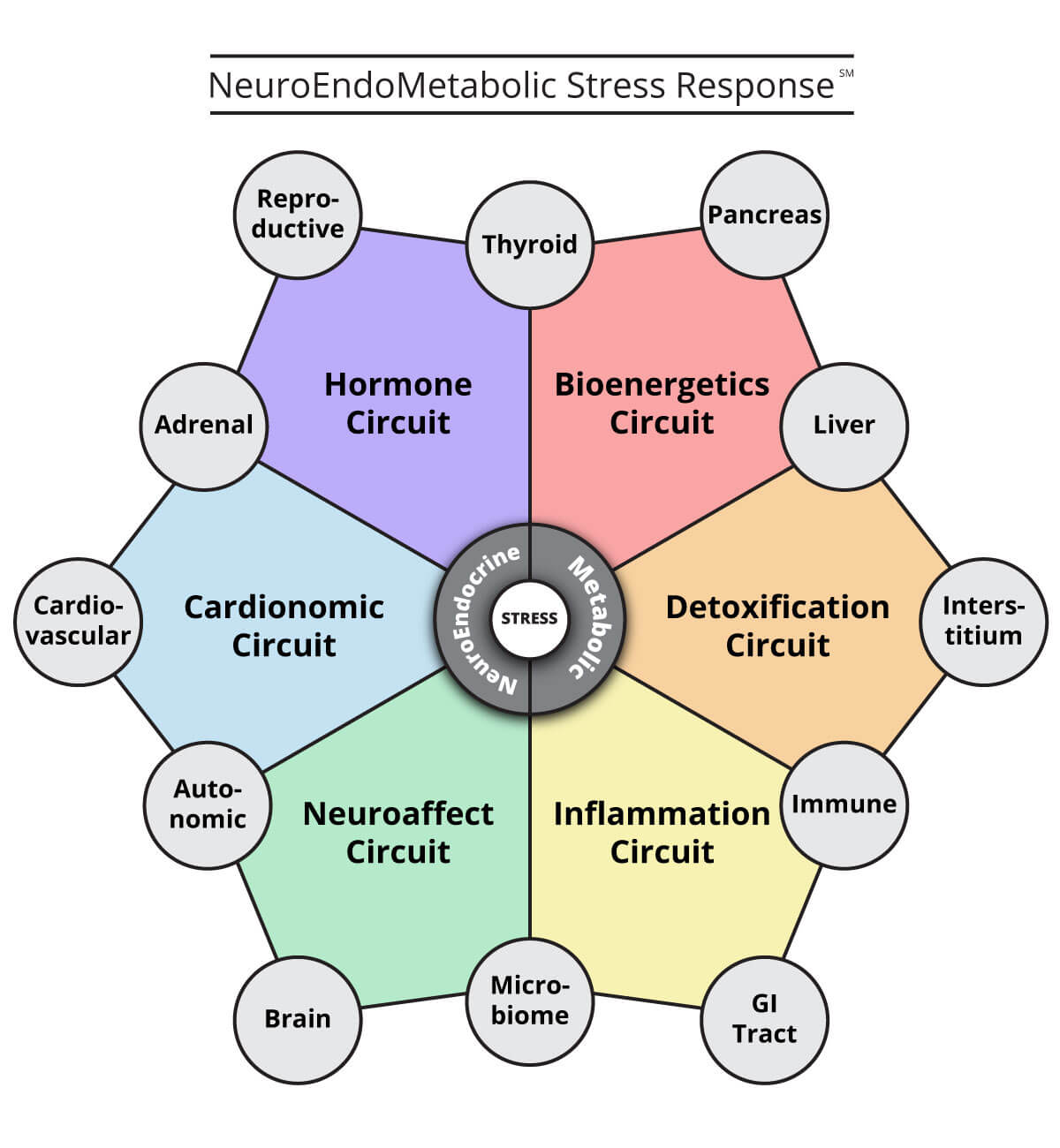
There are two main groups of independent but overlapping circuit breakers responsible for our body’s functional response to stress. They are the neuroendocrine and metabolism response circuits. Both are continuously working twenty-four seven, though the degree varies depending on the severity of insult faced.
The neuroendocrine circuits involve the thyroid, adrenals, heart, autonomic nervous system, brain, and the GI track. They are called into action to help in the body’s anti-stress response when the hypothalamic-pituitary-adrenal (HPA) axis is activated.
The anti-stress metabolism circuits involve the pancreas, liver, extra cellular matrix, immune and microbiome. They are called into action at the same time as the neuroendocrine (NE) system.
It is important to note that the NE circuits involve primarily organ systems, and metabolism circuits involve mostly systemic responses. Both NE and metabolism circuits work concurrently together and are inseparable. What happens in one organ’s stress response will affect all other organs and systems because the body is one closed ecosystem that cannot be compartmentalized when stress arrives at the doorstep. The body’s response to stress is global in nature, utilizing various components on the NEM response system at will. In its infinite wisdom, the body decides which pathways to activate, organs to rest, hormones to put on overdrive as stress reduction cascade is activated. This automatic process has served the survival of our species well.
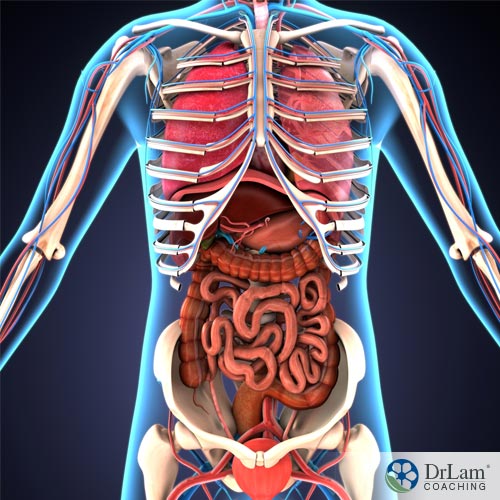 Both circuit groups together form the overall NEM response. Each has three functional components. Therefore there are six functional components all interconnected, working in unison. The three that fall into neuroendocrine circuits are hormone, cardionomic, and neuro-affect. The three that fall into the metabolism circuits are inflammation, detoxification, and metabolism. Each circuit and its functional components are like a section of an orchestra with its own instruments and tools. The sum total of these six components makes up the NeuroEndoMetabolic response to stress from a functional medicine perspective.
Both circuit groups together form the overall NEM response. Each has three functional components. Therefore there are six functional components all interconnected, working in unison. The three that fall into neuroendocrine circuits are hormone, cardionomic, and neuro-affect. The three that fall into the metabolism circuits are inflammation, detoxification, and metabolism. Each circuit and its functional components are like a section of an orchestra with its own instruments and tools. The sum total of these six components makes up the NeuroEndoMetabolic response to stress from a functional medicine perspective.
Normal activation of the NEM response is automatic and takes place twenty-four seven without us knowing. When stress is overwhelming or persistent, the NEM circuit breakers start to malfunction. Disruption of any one or more of these components within the NEM response can lead to negative consequences. The degree of damage of the NEM response will determine the degree of our body’s overall weakness and degree of symptomatology seen clinically. The ultimate clinical presentation is heavily influenced by our genetic backdrop and our lifestyle choices. Everyone’s clinical response to stress therefore is different. Some people can tolerate and in fact thrive on stress, whether physical or emotional. Others may have a nervous breakdown with the slightest insult.
The body’s NEM response does behave logically both on how it is activated and how it can be disrupted, causing multiple decapacitating symptoms of stress.
The following are the six core clinical imbalances that arise from dysregulation of the NEM stress response. Within each area, we will look at their function in stress response, and the consequences when disrupted or damaged.
They are discussed here in order of activation and clinical expression as stress increases and stress response dysfunction intensifies. Remember that only general patterns are presented here, with tremendous individual variations.
The hormone response to stress is regulated primarily by the adrenals, thyroid, and gonads (female ovaries and male testis), with controlling signals starting in the brain. As mentioned before, this has been well studied. The HPA axis as well as the hypothalamic-pituitary-gonadal (HPG) axis is involved as key pathway regulators.
 The adrenal glands, sitting on top of our kidneys, are responsible for secreting cortisol, the most important anti-stress hormone in the body along with over fifty other hormones. Low adrenal function can lead to low thyroid function. The thyroid gland regulates our basal body temperature, the overall speed of stress response. When thyroid function is slowed, fatigue is inevitable. When a body is in a state of fatigue, reproduction is not a priority and libido is reduced. The ovarian-adrenal–thyroid (OAT) hormone axis plays an important balancing role to ensure the body has adequate hormones to deal with reproduction. Disruption of any part of the OAT axis will cause havoc on the other systems.
The adrenal glands, sitting on top of our kidneys, are responsible for secreting cortisol, the most important anti-stress hormone in the body along with over fifty other hormones. Low adrenal function can lead to low thyroid function. The thyroid gland regulates our basal body temperature, the overall speed of stress response. When thyroid function is slowed, fatigue is inevitable. When a body is in a state of fatigue, reproduction is not a priority and libido is reduced. The ovarian-adrenal–thyroid (OAT) hormone axis plays an important balancing role to ensure the body has adequate hormones to deal with reproduction. Disruption of any part of the OAT axis will cause havoc on the other systems.
Disruption of this hormone response can lead to symptoms of stress such as fatigue, exercise intolerance infertility, hair loss, afternoon slump, PMS, low libido, dry skin, menses irregularity, reproductive disruption and infertility, feeling cold when others are warm, and low thyroid function despite thyroid replacement medication. Symptoms tend to be mild, starting with waking up unrefreshed, afternoon slump, and a second wind in the evening. Women may also get fibrocystic breast disease, PMS and menstrual irregularity. Low libido is common. As the NEM response becomes more disrupted, amenorrhea, infertility, and miscarriages can surface.
Thyroid function tends to slow as NEM response progresses. The body tries to conserve energy, and slowing the basal metabolism rate by down-regulating thyroid function is effective. Unfortunately, clinicians unaware that low thyroid function is a compensatory response to stress may initiate thyroid replacement therapy unnecessarily, masking the underlying pathology even more.
The metabolism regulatory organs are comprised primarily of thyroid, pancreas and the liver. A proper metabolism response ensures the body get the right amount of fuel it needs at the right time. It comes as no surprise that one of the body’s early defenses to stress, in addition to HPA axis activation, is activating the metabolism response to increase the basal metabolism rate so the body is on ready mode, with increased glucose delivery to the brain to keep us on alert.
The thyroid is the body’s main regulator of metabolism speed. A slow thyroid function will slow all metabolism pathways. The pancreas plays an important role by way of insulin, the all important regulator of glucose, the fuel of our body. Least appreciated is the role of the liver, the master metabolite clearing house. Working together, they determine the effectiveness of metabolism pathways and reaction in the body.
Deranged metabolism response gives rise to many early warning signs of NEM disruption, such as sugar craving, dyslipidemia, central obesity commonly seen in Stages 1 and 2 of adrenal fatigue. These are rather subtle and often passed off as insignificant by most clinicians as signs of aging. More advanced symptoms of metabolism disruption include reactive hypoglycemia, type 2 diabetes, and weight gain. These are often more present as the adrenals enter exhaustion in Stage 3. In severe cases, weight loss and loss of muscle mass surface as the body surrenders after unsuccessful efforts to restore homeostasis. These are all symptoms of stress. The body enters a shut down mode as the only way it sees fit for survival. The body is usually in late Stage 3 of adrenal fatigue at this time.
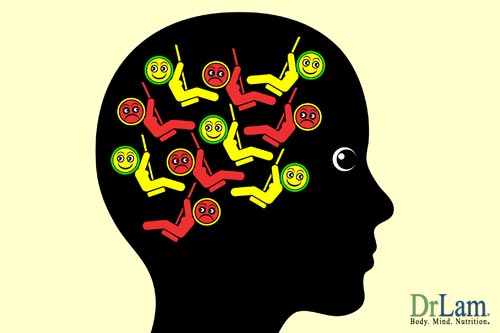 As the metabolism and hormone circuits are fully engaged in the stress response, the central nervous system is inevitably involved as well. Complaints of insomnia, anxiety, depression, mood swings, and brain fog become more prevalent as stress increases.
As the metabolism and hormone circuits are fully engaged in the stress response, the central nervous system is inevitably involved as well. Complaints of insomnia, anxiety, depression, mood swings, and brain fog become more prevalent as stress increases.
Much of the neuro-affect response is regulated by the autonomic nervous system, brain, and the gut.
Remember that stress responses are initiated in the brain, largely in the hypothalamus through the hormone circuit discussed earlier. A variety of neurotranmistters are released to different parts of the brain to maintain our mood in balanced state, while keeping us alert to handle stress, but allowing us to rest when it is time to do so. Some neurotranmistters are transformed or also act as hormones, regulated by the autonomic nervous system. Much of our body’s neurotranmistters are also made in the GI track. The gut is often called the "second brain" for this reason. The microbiome-gut-brain axis is an important regulator pathway of the body’s neurotransmitter pool. Inflammation of the GI track can lead to depression, as we shall see below. Norepinphrine, for example, is an important neurotransmitter that helps support brain alertness within the central nervous system. Symptoms of over activation of norepinephrine centrally include anxiety, panic attack, and insomnia. The autonomic nervous system, however, is the conduit that allows it to exert its effect outside the central nervous system, such as our heart and blood vessels, to get ready for stress. Symptoms of over activation of the autonomic nervous system can result in feeling the heart pounding as if it may "jump out of the body".
The brain, gut, and autonomic nervous systems are therefore the all important triad system responsible for regulating our mood, sleep, and cognition with proper balance. Dysregualtion of this circuit can lead to sleep onset insomnia, sleep maintenance insomnia, anxiety, and panic attack.
As mentioned above, an important part of the body’s overall response to stress is to ready the heart, blood vessels and lungs with more blood filled with oxygen in case physical flight is needed. This function is not activated until the danger of survival becomes imminent. Key hormones required for this "fight-or-flight" response include both norepinephrine and adrenaline. Adrenaline is the body’s most powerful stimulatory hormone by far. It is also known as epinephrine, a hormone released and modulated by the adrenal glands and regulated by the sympathetic nervous system, part of our body’s autonomic nervous system. Excessive release can cause havoc within. A perfect balance of this system, involving the heart, autonomic nervous system and the adrenal glands is needed.
Disruptions of the cardionomic response leads to high blood pressure, dizziness, heart palpitations, cardiac arrhythmia, breathlessness, shortness of breath. In advanced disruptions, POTS like symptoms, PVCs and atrial fibrillation may be experienced. These symptoms of stress are normally seen in those with adrenal exhaustion (Stage 3 of adrenal fatigue) and beyond. An overactive cardionomic circuit puts the entire body’s metabolism on constant overdrive instead of allowing the system to turn itself on and off at will, with adequate and rest for repair in between. This is a short-lived temporary measure by design. Unrelenting stressors put this "fight-or-flight" response in permanent "on" mode which can damage our heart’s normal function.
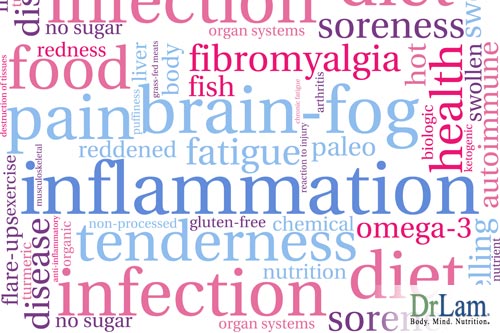 Inflammation is part of the complex biological response of body tissues to harmful stimuli, such as pathogens, toxins, and damaged cells. It is an integral part of our body’s defense apparatus to keep us safe. It involves immune cells, our microbiome, and the gut. Imbalanced gut flora and systemic inflammation are strongly associated. The purpose of inflammation is to eliminate the initial cause of cell injury, clear out necrotic cells and tissues damaged from the original insult and the inflammation process, and to initiate tissue repair. Inflammation is tied therefore to our detoxification system as well.
Inflammation is part of the complex biological response of body tissues to harmful stimuli, such as pathogens, toxins, and damaged cells. It is an integral part of our body’s defense apparatus to keep us safe. It involves immune cells, our microbiome, and the gut. Imbalanced gut flora and systemic inflammation are strongly associated. The purpose of inflammation is to eliminate the initial cause of cell injury, clear out necrotic cells and tissues damaged from the original insult and the inflammation process, and to initiate tissue repair. Inflammation is tied therefore to our detoxification system as well.
In addition, inflammation affects our brain’s response to stress. For example, depression is associated with chronic low grade inflammation response caused by cell-mediated immunity. When the gut is inflamed, gut permeability is increased. Gut cells are generally held tightly together to avoid leakage. Stress, infection, toxin, and antibiotics damage the tight junction, leading to leaking of proteins into the systemic blood stream, bringing with it sugar and other toxins that trigger inflammation. Such toxins can lead to depression within the central nervous system and pain of unknown origin outside. Lipopolysaccharide (LPS), an important marker of leaky gut, is prevalent in autism, depression, Lou Gehrig’s disease, and Alzheimer disease. Commonly used antidepressants called SSRIs have strong anti-inflammation properties that can help reduce depression.
The body’s inflammation response to stress is activated early on, like the metabolism response. Signs and symptoms of inflammation, however, are often subtle and too minor to be detected. inflammation markers, such as C-reactive protein (CRP) can be elevated, but passed over as insignificant. It is not until inflammation is rampant that the body begins to shown clinical signs such as food sensitivity, leaky gut, inflammation bowl disease, irritable bowl disease, and musculoskeletal pain of unknown origin. Joint surfaces are easy targets of inflammation and destructive processes that result in pain. Neurogenic and musculoskeletal inflammation is often mediated by the sensory nervous system through the release of pro inflammation compounds that arise from sensory nerves in tissues. These compounds are activated by a wide variety of triggers including allergens and environmental chemicals.
Failure to properly regulate and suppress excessive inflammation can ruin our body. Disruption of this system can lead to symptoms such as recurrent infections, frequent colds and slow to heal, proliferation of autoimmune disorders, increased food sensitivities, stealth virus presence, exacerbation of EB virus, candida, and failure to recover from Lyme disease, SIBO, IBS, leaky gut, and musculoskeletal pain.
Environmental toxins and excessive stress increases oxidative stress and robs our cells of necessary electron flow, leading to premature cell death and excessive cellular debris. The body’s ability to clear metabolites, biotoxins, and toxic by-products on a timely basis is critical to avoid congestion and toxin accumulation. The liver, extracellular matrix and immune system are the key players that ensure an unpolluted body with a clean sewage system. In particular, the liver, as the main clearance center of the body, must be kept in optimum shape. The extracellular matrix and the immune system support these processes along with the liver as do the lymphathic system and kidneys, which also play important roles.
 Stress induced oxidative damage and excessive metabolite overload can become toxic in the body if not promptly removed by the liver and the extracellular matrix. Toxins from everyday pollution, medications, alcohol, smoke, and hydrogenated fats accumulate in our extracellular matrix, causing congestion. They also cross into the cell wall and damage intracellular organelles such as mitochondria . Cellular integrity is invariably compromised when the body is in a toxic environment. Both the intracellular space and extracellular matrix needs to be optimized to remove toxins promptly and help in the detoxification process. Oxidative damage to cell walls by heavy metal in our water and gaseous pollutants in the air we breath can damage cell health. Receptor sites can also be damaged by prescription medications and recreational drugs. The extracellular matrix response for cell to cell signaling and transportation of intercellular messengers and scaffolding to support organ structure, can be congested, chocking our cell’s respiratory and energy production chain. Without proper detoxification, the immune system is compromised, and premature cell death occurs.
Stress induced oxidative damage and excessive metabolite overload can become toxic in the body if not promptly removed by the liver and the extracellular matrix. Toxins from everyday pollution, medications, alcohol, smoke, and hydrogenated fats accumulate in our extracellular matrix, causing congestion. They also cross into the cell wall and damage intracellular organelles such as mitochondria . Cellular integrity is invariably compromised when the body is in a toxic environment. Both the intracellular space and extracellular matrix needs to be optimized to remove toxins promptly and help in the detoxification process. Oxidative damage to cell walls by heavy metal in our water and gaseous pollutants in the air we breath can damage cell health. Receptor sites can also be damaged by prescription medications and recreational drugs. The extracellular matrix response for cell to cell signaling and transportation of intercellular messengers and scaffolding to support organ structure, can be congested, chocking our cell’s respiratory and energy production chain. Without proper detoxification, the immune system is compromised, and premature cell death occurs.
It comes as no surprise that as the detoxification burden increases, symptoms of a toxic ecosystem emerges. They include emergence of paradoxical reactions, hypersensitivity, supplement and medication intolerance, and chemical sensitivities.
Here is a table breaking down the six responses with their corresponding symptoms of stress and organs involved.
| Stress Response Circuit | Primary Systems and Organs Involved | NEM Response Activation and Overdrive | NEM Response Exhaustion and Failure |
|---|---|---|---|
| Hormone | Adrenals-Thyroid-Gonads | Estrogen dominance, low libido, premenstrual syndrome (PMS), endometriosis, polycystic ovary syndrome (PCOS), amenorrhea, erectile dysfunction. | Low cortisol output, thyroid resistance, brittle adrenal. |
| Bioenergetics | Thyroid-Pancreas-Liver | Sugar cravings, salt cravings, dyslipidemia, weight gain, metabolic syndrome. | Carbohydrate dependency, carbohydrate intolerance, catabolic state, liver congestion, organ resistance, reactive hypoglycemia. |
| Detoxification | Liver-Interstitium-Immune | Hypersensitivity to drugs and supplements, sensitivity to food, pain of unknown origin. | Paradoxical reactions, electromagnetic field (EMF) sensitivity, chemical sensitivities, recurrent crashes, retoxification reaction, reactive metabolite overload. |
| Inflammation | Immune-Microbiome-Gut | Food sensitivities, leaky gut, irritable bowel syndrome (IBS), recurrent infections, Epstein-Barr virus (EBV). | Recurrent and stealth infection, autoimmune disorders, systemic candida, small intestinal bacterial overgrowth (SIBO), inflammatory bowel disease (IBD). |
| Neuroaffect | Gut-Brain-ANS | Mood swings, anxiety, sleep onset insomnia (SOI), sleep maintenance insomnia (SMI), stress intolerance. | Adrenaline rushes, panic attacks, depression, neurotransmitter imbalances. |
| Cardionomic | ANS-Heart-Adrenals | Heart palpitations, tachycardia, sub-clinical postural orthostatic tachycardia syndrome (POTS). | Shortness of breath, breathlessness, premature ventricular contractions (PVC), atrial fibrillation, clinical POTS. |
Your body’s stress response testing begins with the hypothalamic-pituitary-adrenal HPA) hormonal axis. The organ responsible rest with the adrenals, where multiple hormones are excreted as a result. Three tests give you an insight as to the situation of your HPA axis function. They are the salivary DHEA (dehydroepiandrosterone – a hormone produced by the adrenal glands), salivary cortisol, and pregnenolone tests. These tests are, however, only indicative of a possible problem and results cannot be seen as definite without clinical correlation. Only an experienced clinician is able to interpret tests because mistakes are possible and results can be confusing as they may not necessarily reflect the underlying root cause of the problem. Because there is so much variance in results, the analysis made by a computer should not be regarded as final, but rather only been used as a general guideline for educational purposes.
There are, however, a number of more advanced tests that gives a more complete evaluation of your NEM stress response. These tests are:
Your salivary immunoglobulin A, or SlgA, is a part of your immune system’s ‘first line of defense’ when your body is confronted with pathogens, bacteria, and viruses. SlgA is considered a reliable biomarker when discerning gastrointestinal (GI) health when it comes to conditions such as allergies, leaky gut, candida, food sensitivities, and small intestinal bacterial overgrowth (SIBO).
Children and older people with saliva that has lower SlgA concentrations tend to have a higher risk of contracting periodontal diseases, caries, and upper respiratory tract infections. While there is no difference in SlgA levels when compared between males and females, individual differences have been identified when infection responses are determined and are thus deemed a risk factor.
Your saliva and serum’s SlgA levels, however, have no bearing on each other. Whereas the main immunoglobin in your immunoglobin mucus secretion happens to be SlgA, your intestinal cells only produce between two to three grams daily, with production at its highest during early childhood. SIgA production, however, starts declining after about the age of six years.
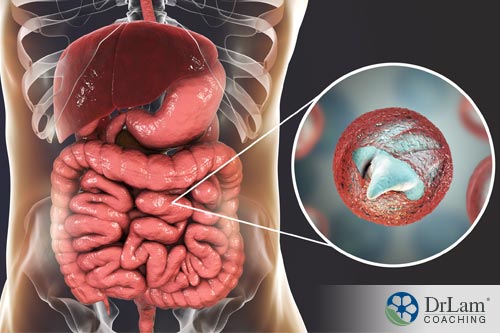 Although we tend to think of mucus as being found only in the nose and sinuses, your gut actually has a whole lot more. Your mucus lining is the body’s first line of defense when it comes to all gastrointestinal pathogens, including parasites, viruses, bacteria, fungi, toxins, and food proteins.
Although we tend to think of mucus as being found only in the nose and sinuses, your gut actually has a whole lot more. Your mucus lining is the body’s first line of defense when it comes to all gastrointestinal pathogens, including parasites, viruses, bacteria, fungi, toxins, and food proteins.
To put things in a nutshell, carcinogens, micro-organisms, and food proteins are prevented from binding to absorptive cell surfaces because of the SlgA antibodies’ actions. The SIgA antibodies attach themselves to any invading pathogens, and in doing so, effectively traps them in the mucus, thereby disabling them from moving through the body. Toxins given off by the pathogens are then neutralized before excretion by means of your feces.
The SIgA antibodies also identify food that it deems to be acceptable and non-invasive. This leads us to the conclusion that lower SIgA levels may be instrumental in developing intolerances and allergies when it comes to certain foods.
Although SIgA and serum IgA are related, they are not the same. Serum IgA is often checked together with Immunoglobulin E ( IgE) and Immunoglobulin G (IgG) when blood tests are conducted in order to ascertain immunity and possible allergies. The two, i.e. SigA and serum IgA, are independent of each other. If the levels of one are normal, it does not necessarily mean that the same goes for the other. You thus always need to check each independently of the other when doing blood tests.
People with a lower IgA tend to have a higher propensity for immune-related problems such as infections, chronic skin problems, and allergies and find it more difficult to control instances of Candida. Those who are most at risk of contracting immune related issues are those with chronic stress, those within the autistic spectrum, or who have ulcerative colitis or Crohn’s disease.
Lower IgA levels indicate a weakened body that has only a limited ability to overcoming infections. The adrenals are exhausted, as is shown by fatigue, crashes, relapses, and prolonged recovery. The immune system has difficulty in coping.
High SIgA levels, on the other hand, is indicative of a sub-clinical system infection that points to leaky gut syndrome (irritable bowel syndrome or OBS).
Your SIgA levels can thus be regarded as an advanced marker when it comes to the NEM stress response with regards to inflammation, detoxification, the immune system, and gastric system.
Your body’s serum and salivary CRP levels are usually not very high under normal conditions although they severely increase during the latter stages of adrenal fatigue. Research indicates that there may be a link between the occurrence of stroke and heart attack incidences and your body’s CRP levels. This thus suggests that CRP levels could be used as a yardstick to monitor your body’s cardiovascular health and to predict the possibility of any future coronary problems. Numerous research studies have taken a look at the correlation between CRP and diseases, including diabetes, autoimmune disorders, hypertension, and cancer. They have also indicated a strong possibility of a link between various health issues such as heart disease, oral health, inflammation, and chronic infections.
 Salivary alpha Amylase is a protein enzyme that may be used as a possible potential biomarker when it comes to the activation of the sympathetic (autonomic) nervous system. Autonomic nervous signals control the release of sAA the secretion by the salivary glands. A lot of research points to the release of sAA when the body experiences stress. This stress may be due to physiological reasons, such as heat, cold, or exercise, or due to psychological reasons, for example, the stress related to taking a written test. People perceive these examples as stressful situations and symptoms of stress can result. Interestingly, studies do not indicate that there is necessarily a correlation between sAA and cortisol during stressful conditions. This thus suggests that the sAA differences that are seen may mean that the protein enzyme’s stress response happens to be independent of the stress response as experienced by your HPA axis.
Salivary alpha Amylase is a protein enzyme that may be used as a possible potential biomarker when it comes to the activation of the sympathetic (autonomic) nervous system. Autonomic nervous signals control the release of sAA the secretion by the salivary glands. A lot of research points to the release of sAA when the body experiences stress. This stress may be due to physiological reasons, such as heat, cold, or exercise, or due to psychological reasons, for example, the stress related to taking a written test. People perceive these examples as stressful situations and symptoms of stress can result. Interestingly, studies do not indicate that there is necessarily a correlation between sAA and cortisol during stressful conditions. This thus suggests that the sAA differences that are seen may mean that the protein enzyme’s stress response happens to be independent of the stress response as experienced by your HPA axis.
High levels of alpha amylase indicate that your body is undergoing high levels of stress. When your body’s sAA and cortisol levels are measured and compared it gives you valuable insights as to the nature of the different interactions between the HPA axis and the autonomic nervous system (ANS) when looking at different types of stress responses or different psychological conditions. With regards to the NEM stress response, valuable insights are garnered when it comes to the cardionomic, neuro-affective, and hormonal systems.
The cytokine protein interlukine-1 beta is also known as a leukocytic endogenous mediator, lymphocyte activating factor or leukocytic pyrogen. Cytokines are manufactured by many different types of cells in the body, amongst these being monocytes, dendritic cells, fibroblasts, and macrophages. Interlukine-1beta is a pro-inflammatory cytokine because of its involvement in your body’s inflammation response during chronic or acute infections or when it is subjected to those conditions that result in it being exposed to constant low-grade inflammation, such as is the case with people who are obese. The interlukine-1beta protein is thus a reliable indicator of whether inflammation is present.
The cytokine protein interlukine-1beta is usually released after the body is subjected to antigens, or as a result of infections or injury. It is, in fact, a molecule that is released to signal the presence of infection, and usually from the body’s immune cells, although quite a number of other cell varieties present in your body’s tissue also secretes it. Examples include its presence in your saliva (because of the presence of and production by immune cells), certain cells in the saliva glands, and other tissues in the oral cavity. Some of this cytokine, by means of the gingival crevicular fluid (GCF) that is secreted by gum tissue next to the teeth also ends up in your saliva.
The cytokine protein interlukin-1beta is a marker for inflammation, one of the main components of your body’s NEM stress response system.
One needs to remember that the NEM stress response system’s advanced markers are not, individually, definitive. This is because each of them points to a certain function, giving but an indication of the body’s response to stress. You should thus not depend on only one test in order to make a concrete diagnosis. Instead, for clinical reasons, you should rather make comparisons, using the different tests, while at the same time looking at the person in question’s medical history, and symptoms of stress before coming to any form of specific, concrete conclusion.
 In the modern world stress has become an inescapable part of living. The body’s Neuroendometabolic (NEM) stress response self-regulation system protects us from excessive stress. The six stress responses are inflammation, neuro-affective, cardionomic, hormone, metabolism, detoxification, and inflammation. Utilizing various organs and systems, an orchestrated anti-stress response is mounted. Together they work in unison to attempt to restore the body to normal function, provided the body has the tools to affect this. Because the natural progression is a downward or worsening cascade, failure to recover or severe disruption of the NEM stress response can cause great harm to the body. Incorporating this functional model into our understanding of the body’s stress response helps us to understand the pathophysiology of the symptoms of stress and helps sufferers to recover.
In the modern world stress has become an inescapable part of living. The body’s Neuroendometabolic (NEM) stress response self-regulation system protects us from excessive stress. The six stress responses are inflammation, neuro-affective, cardionomic, hormone, metabolism, detoxification, and inflammation. Utilizing various organs and systems, an orchestrated anti-stress response is mounted. Together they work in unison to attempt to restore the body to normal function, provided the body has the tools to affect this. Because the natural progression is a downward or worsening cascade, failure to recover or severe disruption of the NEM stress response can cause great harm to the body. Incorporating this functional model into our understanding of the body’s stress response helps us to understand the pathophysiology of the symptoms of stress and helps sufferers to recover.
Get a good night rest, do more adrenal breathing exercises, keep well hydrated, and eat frequently.
If you have advanced stages of AFS and are on a budget, it is best to take the right nutrients to strengthen your body and the adrenals before you embark on a heavy duty detoxification program.